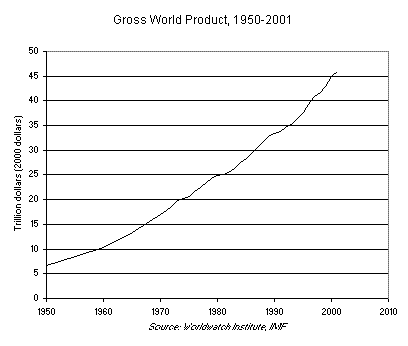"Plan B is shaped by what is needed to save civilization, not by what may currently be considered politically feasible." –Lester R. Brown, Plan B 3.0: Mobilizing to Save Civilization
Click here to view the most recent Global Economy Indicator and Data
In 2001, the global economy expanded by scarcely 2 percent, the slowest rate in many years. With growth in the economy barely exceeding that of population, gross domestic product per person climbed from $7,392 to $7,454, a gain of less than 1 percent.
Much of the global slowdown was attributable to the United States-both because it is far and away the world's largest economy and because it is the principal export market for so many countries. After expanding by a robust 4.1 percent in 2000, the U.S. economy grew by only 1.2 percent in 2001. Meanwhile, the Canadian economy was slowing in sync, dropping from an increase of 4.4 percent to 1.5 percent.
In Western Europe, the four large industrial countries all experienced declines in growth in 2001. France, Italy, and the United Kingdom each dropped from 3 percent or better to around 2 percent, while Germany--the largest of the four--fell from 3 percent to less than 1.
Growth in Latin America's large economies also slowed substantially. Brazil, the region's biggest, dropped from 4.4-percent growth to 1.5 percent. Argentina, in serious difficulty in recent years as a result of the cumulative effects of economic mismanagement, saw its economy shrink by nearly 5 percent in 2001. (Worse is yet to come there in 2002.) In Mexico, the other large economy in the region, growth dropped from 6.6 percent in 2000 to zero in 2001--one of the biggest drops recorded among the world's larger economies.
Economic growth was also losing momentum in the Middle East. For Saudi Arabia, the world's leading oil exporter, it dropped from 4.5 percent in 2000 to 2.2 percent in 2001. For Iran, growth remained steady at 5 percent in 2000 and 2001. Egypt, meanwhile, dropped from 5 percent to just over 3 percent.
In Asia, Japan continued to perform poorly, going from a modest growth of 2.2 percent in 2000 to an actual decline in 2001 (at -0.4 percent). Until it considers major economic reforms, including clearing up a dangerously heavy load of bad bank loans, Japan will have trouble sustaining economic growth. South Korea, which had achieved 9-percent growth in 2000, saw its expansion drop to 3 percent in 2001.
The developing countries of Southeast Asia, meanwhile, did not fare well. Their overall growth rate declined. Indonesia dropped from nearly 5 percent to 3 percent. Thailand dropped from 4.6 percent to 1.8. Malaysia, however, took a bigger hit, dropping from 8-percent growth to nearly zero.
In 2001, India's growth dropped from 5.4 to 4.3 percent and Bangladesh's from 5.5 to 4.5 percent. Pakistan was stable, with an expansion of just under 4 percent in both 2000 and 2001.
China continued as the star economic performer of the region, expanding by 8 percent in 2000 and dropping only slightly to 7.3 percent in 2001. Questions remain, however, about economic accounting in China, with several indirect indicators suggesting that growth has been consistently overstated.
In the former Soviet republics, Russia's economic growth dropped from 9 percent in 2000 to 5 percent in 2001. In contrast, the Ukrainian economy, which has been struggling for many years, went against the tide--expanding from 6-percent growth in 2000 to 9 percent in 2001.
In Africa, a few countries also countered the global trend of slower growth. Algeria's economy climbed from 2.4-percent growth in 2000 to 3.5 percent in 2001. Morocco grew from 2.4 percent to 6.3 percent. And Nigeria, helped by rising oil prices, held steady at 4 percent.
Economic and social progress have not come easily in Africa. Although the region's economy resumed growth during the last decade, it was not able to match the increase in population. As a result, income per person in sub-Saharan Africa declined by some 12 percent from 1980 to 1999. Life expectancy, perhaps the best social indicator of progress, is only 50 years, and that may fall during this decade as the HIV epidemic shortens millions of lives.
What these data on economic growth from the International Monetary Fund do not show is the share of economic output that is environmentally unsustainable. Available evidence suggests that as much as 8 percent of the world grain harvest may be based on the unsustainable use of water. At some point, overpumping of water will come to a halt either because it is too costly to pump from a continually falling water table or, perhaps more likely, because the aquifer is depleted. If it is a rechargeable aquifer, depletion means that pumping will necessarily be reduced to the rate of recharge. If it is a fossil aquifer--that is, nonrechargeable--pumping ends.
A similar situation exists for forest products, where clearcutting and the shrinkage of the remaining forested area are reducing the long-term yield of the earth's forests. Deforestation may initially have a positive effect, but it brings its own set of costs in soil erosion and flooding.
Fisheries, too, are being overharvested in order to maximize short-term income. Some three fourths of oceanic fisheries are being fished at or beyond their sustainable yield. In some cases, governments are cutting back on the catch to try and save the fisheries. In others, the fisheries are simply collapsing. The result is the same: a reduced overall catch.
These and many other trends simply underline the risks associated with dependence on economic data that do not distinguish between sustainable and unsustainable output. The failure to do so is leading to an exaggerated sense of progress and to a false sense of security.
Copyright © 2002 Earth Policy Institute


 Print:
Print:  Email
Email

